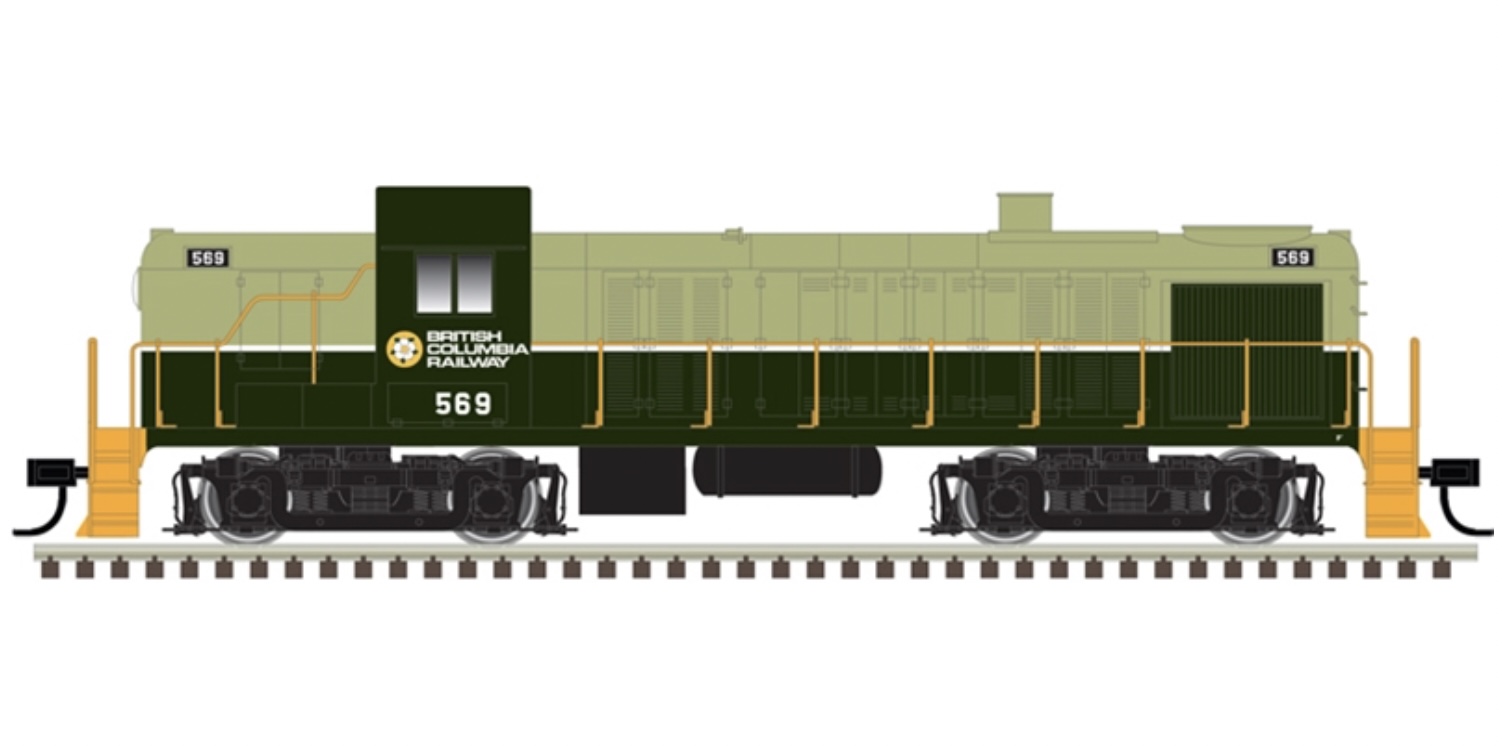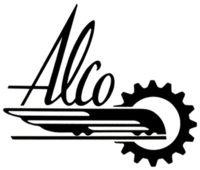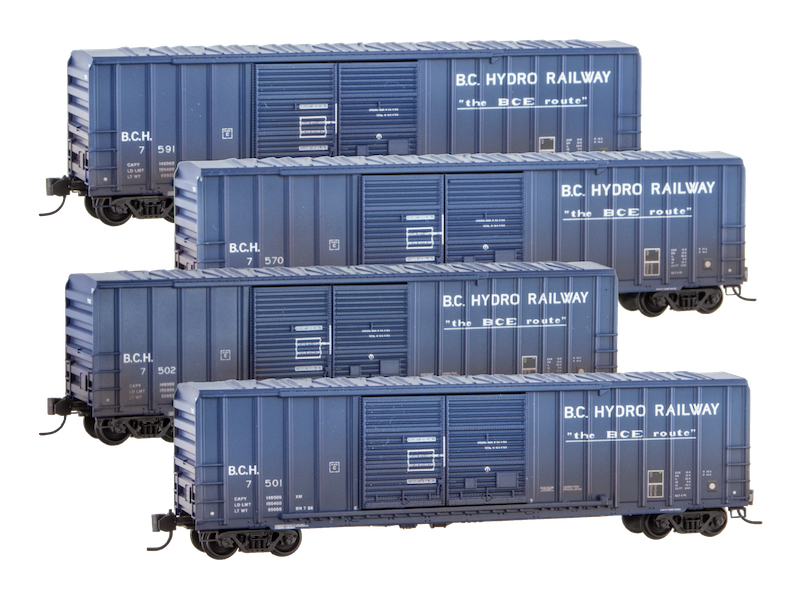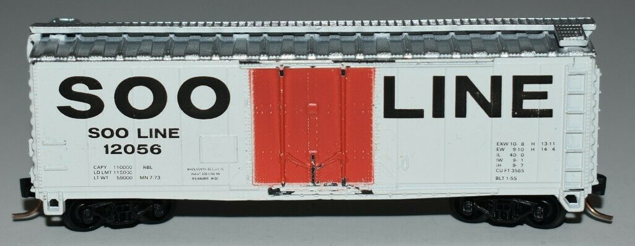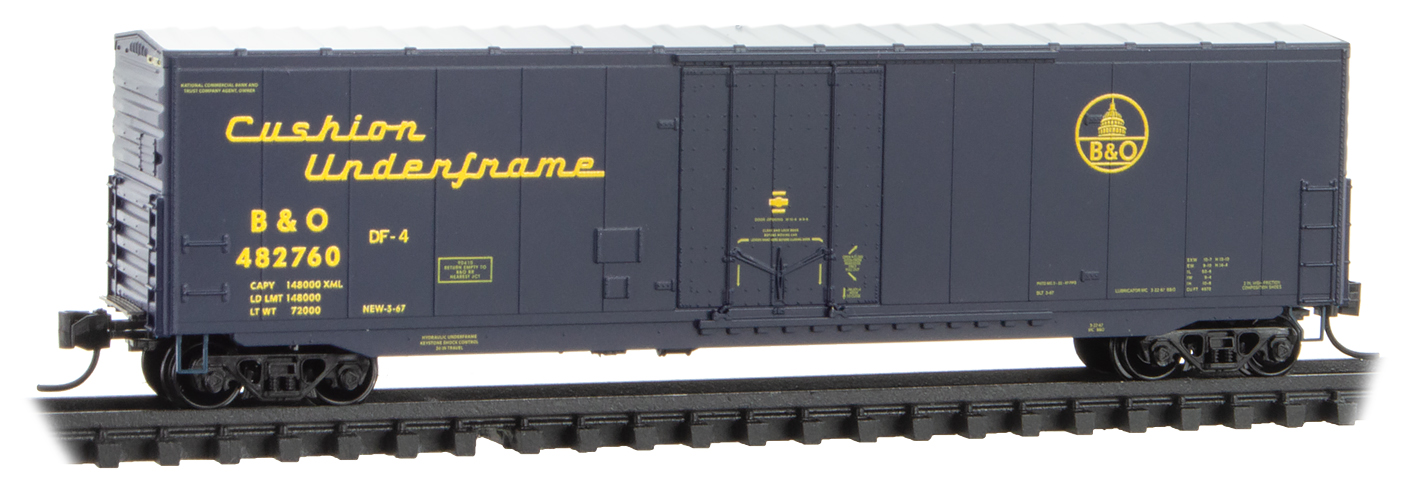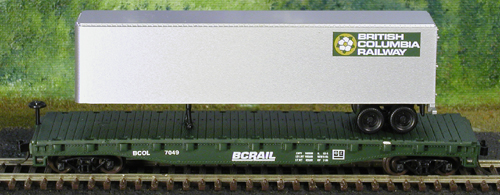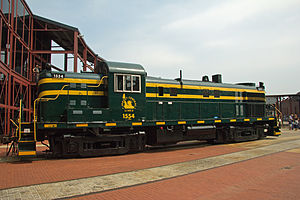Atlas - 40 005 497 - Locomotive, Diesel, Alco RS-3 - BC Rail - 561
| Production Type | Announced |
| Stock Number | 40 005 497 |
| Secondary Stock Number | 40005497 |
| Original Retail Price | $249.95 |
| Brand | Atlas |
| Manufacturer | Atlas |
| Body Style | Atlas Diesel Road Switcher RS-3 |
| Image Provider's Website | Link |
| Prototype Vehicle | Locomotive, Diesel, Alco RS-3 (Details) |
| Road or Company Name | BC Rail (Details) |
| Road or Reporting Number | 561 |
| Paint Color(s) | Two-Tone Green |
| Print Color(s) | White & Yellow |
| Coupler Type | AccuMate Magnetic Knuckle |
| Coupler Mount | Body-Mount |
| Wheel Type | Chemically Blackened Metal |
| Wheel Profile | Small Flange (Low Profile) |
| DCC Readiness | DC/DCC Dual Mode Decoder w/Sound |
| Announcement Date | 2022-06-17 |
| Item Category | Locomotives |
| Model Type | Diesel |
| Model Subtype | Alco |
| Model Variety | RS-3 |
| Prototype Region | North America |
| Prototype Era | NA Era III: Transition (1939 - 1957) |
| Scale | 1/160 |
Specific Item Information:
ESU LokSound Features
Model Information:
Atlas introduced the Kato-produced RS-3 in 1983. They followed up with the RSD-4/5 in 1987 (also Kato-produced). Kato also recyled the chassis for use in their RS-11. Atlas redesigned the RS-3 in 1999 and production moved to China. The models were again modified in 2001 (RS-3) and 2004 (RS-4/5) and from then on featured Atlas "Slow-Speed" motors. The Chinese RS-3 and RSD-4/5 share the same internal mechanism.
The early releases were the first locomotive produced by Kato for Atlas. It was vastly superior to the earlier models produced by Roco for Atlas. The combination of the split-frame design, directional lighting and 5-pole motor with bearing blocks to hold the worm gear in place made it the first "modern" N-Scale design for a North American locomotive. The 2001 Chinese version is very similar to the Kato version.
The Atlas-China version features: Golden-white LEDs; Directional lighting; Separately-applied painted handrails (where appropriate); Blackened metal wheels; Scale Speed™ motor and Accurate painting and printing.
The early releases were the first locomotive produced by Kato for Atlas. It was vastly superior to the earlier models produced by Roco for Atlas. The combination of the split-frame design, directional lighting and 5-pole motor with bearing blocks to hold the worm gear in place made it the first "modern" N-Scale design for a North American locomotive. The 2001 Chinese version is very similar to the Kato version.
The Atlas-China version features: Golden-white LEDs; Directional lighting; Separately-applied painted handrails (where appropriate); Blackened metal wheels; Scale Speed™ motor and Accurate painting and printing.
DCC Information:
Unfortunately the one modern feature this model lacks is a single-lightboard design to permit a "drop-in" decoder board installation. The split-board requires some soldering and careful installation to upgrade even the most modern edition of this locomotive to DCC. Special split decoders are available to convert these models to DCC. Some soldering required. TCS makes the 1278-CN which works pretty well.
TCS CN decoder installation shown on Brad Myers' N-scale DCC decoder installs blog and on TCS website.
A classical wired DCC decoder detailed installation was available on maritime.dns.ca/mgerrits/trains (website no longer exists).
TCS CN decoder installation shown on Brad Myers' N-scale DCC decoder installs blog and on TCS website.
A classical wired DCC decoder detailed installation was available on maritime.dns.ca/mgerrits/trains (website no longer exists).
Prototype History:
Introduced in 1950, the all-purpose, 1600-HSP RS-3 diesel locomotive had the stamina and strength for freight and passenger service yet was agile enough for yard work. With its rugged, dependable design, it's no wonder that many of these versatile RS-3 locomotives are still working today on short lines, tourist lines, and hauling freight. The ALCO RS-3 is a 1,600 hp (1.2 MW), B-B road switcher diesel-electric locomotive. It was manufactured by American Locomotive Company (ALCO) and Montreal Locomotive Works (MLW) from May 1950 to August 1956, and 1,418 were produced - 1,265 for American railroads, 98 for Canadian railroads, 48 for Brazilian and 7 for Mexican railroads. It has a single, 12 cylinder, model 244 engine.
Well over 1,300 RS-3 road-switcher locomotives were built by ALCO between 1950 and 1956. It can be considered one of the most successful four-axle diesel road-switchers ever produced by the builder. These 1,600hp locomotives were powered by an ALCO 244 V-12 engine which was complimented by rugged GE electrical components. The RS-3 was truly a versatile locomotive. It could be found in virtually every type of service from passenger and commuter runs to heavy-haul and local freight assignments. Original owners of the RS-3 tended to be in the eastern and central regions of the US (with heavier concentrations in the northeast and southeast).
During this same time-period, ALCO offered a six-axle road-switcher which was more commonly found in the west. The RSD-4/5 was externally very similar to the RS-3, having six-axle trucks as an obvious spotting feature. They produced the same 1,600hp as an RS-3, but offered increased tractive effort due to the use of a larger generator. Many RSD-4/5s were assigned to operate in mountainous territory (with varying degrees of success) on the Southern Pacific, Santa Fe and the Utah Railway.
Well over 1,300 RS-3 road-switcher locomotives were built by ALCO between 1950 and 1956. It can be considered one of the most successful four-axle diesel road-switchers ever produced by the builder. These 1,600hp locomotives were powered by an ALCO 244 V-12 engine which was complimented by rugged GE electrical components. The RS-3 was truly a versatile locomotive. It could be found in virtually every type of service from passenger and commuter runs to heavy-haul and local freight assignments. Original owners of the RS-3 tended to be in the eastern and central regions of the US (with heavier concentrations in the northeast and southeast).
During this same time-period, ALCO offered a six-axle road-switcher which was more commonly found in the west. The RSD-4/5 was externally very similar to the RS-3, having six-axle trucks as an obvious spotting feature. They produced the same 1,600hp as an RS-3, but offered increased tractive effort due to the use of a larger generator. Many RSD-4/5s were assigned to operate in mountainous territory (with varying degrees of success) on the Southern Pacific, Santa Fe and the Utah Railway.
Road Name History:
BC Rail (reporting mark BCOL, BCIT), known as the British Columbia Railway between 1972 and 1984 and as the Pacific Great Eastern Railway (PGE) before 1972, was a railway that operated in the Canadian province of British Columbia between 1912 and 2004. It was a class II regional railway and the third-largest in Canada, operating 2,320 km (1,440 mi) of mainline track. Its operations were owned by the public as a crown corporation from 1918 until 2004, when the provincial government leased operations for 999 years to CN. The track and other assets, including a marine division and stevedoring subsidiary as well as large tracts of real estate, remain under public ownership. 40 km of track serving the Roberts Bank Superport that were scheduled to be sold to OmniTRAX remain under BC Rail management due to that sale being cancelled because of the transaction being tainted by an influence-peddling and bribery scandal resulting in convictions in 2010. The provincial government, which promised when originally elected to never sell the railway, has announced that the crown corporation and its remaining operations and assets would be "wound down" and taken over by various departments of the Ministry of Transportation The details of the sale/lease to CN, which are related to the OmniTRAX affair, have become the subject of protracted public inquiry as part of the proceedings of the trial surrounding a scandal known as the British Columbia Legislature Raids Affair, or "Railgate". Government leaders and civil servants involved with the arrangements to CN have refused to comment on the deal because the matter "is before the courts".
Chartered in 1912, the railway was acquired by the provincial government in 1918 after running into financial difficulties. A railway that ran "from nowhere, to nowhere" for over 30 years, neither passing through any major city nor interchanging with any other railway, its southern terminus was at Squamish and its northern terminus at Quesnel during that period. It expanded significantly between 1949 and 1984. Primarily a freight railway, it also offered passenger service, as well as some excursion services, most notably the Royal Hudson excursion train. The railway's operations only reached profitability in 1980, due to large capital and operating debts, which were intended as subsidies to develop and sustain mining and timber economies and employment in the regions it accessed, though during the 1980s it regularly posted significant profits, contributing to the public treasury significantly, and maintained a lower operating debt than any of the continent's other major railways. The railway's operations and management, as one of the province's largest crown corporations, have necessarily been at the centre of public debate since its takeover. Notably, as example, the Social Credit governments of WAC Bennett and his son Bill Bennett forgave the railways' capital debts in 1954 and 1979, respectively, with bookkeeping matters related to that bringing much criticism. The current provincial government has been accused of fabricating falsehoods about the state of its debts and viability in order to justify the deal with CN, claiming the railway was in disarray. Other participants in the bidding process withdrew their bids, saying that CN had unfair access to confidential information about their own operations, provided by the government, and at least one bidder (Canadian Pacific) privately stated in since-released communications that the bid was "rigged". Controversy over CN's management of the line has focused on layoffs, toxic spills and other safety concerns, and cuts in service to some regions. The line has generated profits for CN in the range of $25 million per year since its takeover of the railway's operations.
Chartered in 1912, the railway was acquired by the provincial government in 1918 after running into financial difficulties. A railway that ran "from nowhere, to nowhere" for over 30 years, neither passing through any major city nor interchanging with any other railway, its southern terminus was at Squamish and its northern terminus at Quesnel during that period. It expanded significantly between 1949 and 1984. Primarily a freight railway, it also offered passenger service, as well as some excursion services, most notably the Royal Hudson excursion train. The railway's operations only reached profitability in 1980, due to large capital and operating debts, which were intended as subsidies to develop and sustain mining and timber economies and employment in the regions it accessed, though during the 1980s it regularly posted significant profits, contributing to the public treasury significantly, and maintained a lower operating debt than any of the continent's other major railways. The railway's operations and management, as one of the province's largest crown corporations, have necessarily been at the centre of public debate since its takeover. Notably, as example, the Social Credit governments of WAC Bennett and his son Bill Bennett forgave the railways' capital debts in 1954 and 1979, respectively, with bookkeeping matters related to that bringing much criticism. The current provincial government has been accused of fabricating falsehoods about the state of its debts and viability in order to justify the deal with CN, claiming the railway was in disarray. Other participants in the bidding process withdrew their bids, saying that CN had unfair access to confidential information about their own operations, provided by the government, and at least one bidder (Canadian Pacific) privately stated in since-released communications that the bid was "rigged". Controversy over CN's management of the line has focused on layoffs, toxic spills and other safety concerns, and cuts in service to some regions. The line has generated profits for CN in the range of $25 million per year since its takeover of the railway's operations.
Brand/Importer Information:
In 1924 Stephan Schaffan, Sr. founded the Atlas Tool Company in Newark, New Jersey. In 1933 his son, Stephan Schaffan, Jr., came to work for his father at the age of sixteen. Steve Jr. built model airplanes as a hobby and frequented a local hobby shop. Being an enterprising young man, he would often ask the owner if there was anything he could do to earn some extra spending money. Tired of listening to his requests, the hobby-store owner threw some model railroad track parts his way and said, "Here, see if you can improve on this".
In those days, railroad modelers had to assemble and build everything from scratch. Steve Jr. created a "switch kit" which sold so well, that the entire family worked on them in the basement at night, while doing business as usual in the machine shop during the day.
Subsequently, Steve Jr. engineered the stapling of rail to fiber track, along with inventing the first practical rail joiner and pre-assembled turnouts and flexible track. All of these products, and more, helped to popularize model railroading and assisted in the creation of a mass-market hobby. The budding entrepreneur quickly outgrew the limitations of a basement and small garage operation. Realizing they could actually make a living selling track and related products, Steve and his father had the first factory built in Hillside, New Jersey at 413 Florence Avenue in 1947. On September 30, 1949, the Atlas Tool Company was officially incorporated as a New Jersey company.
In 1985, Steve was honored posthumously for his inventions by the Model Railroad Industry Association and was inducted into the Model Railroad Industry Hall of Fame in Baltimore, Maryland. In addition, Steve was nominated and entered into the National Model Railroad Association Pioneers of Model Railroading in 1995.
In the early 1990s, the Atlas Tool Company changed its name to Atlas Model Railroad Company, Inc.
In those days, railroad modelers had to assemble and build everything from scratch. Steve Jr. created a "switch kit" which sold so well, that the entire family worked on them in the basement at night, while doing business as usual in the machine shop during the day.
Subsequently, Steve Jr. engineered the stapling of rail to fiber track, along with inventing the first practical rail joiner and pre-assembled turnouts and flexible track. All of these products, and more, helped to popularize model railroading and assisted in the creation of a mass-market hobby. The budding entrepreneur quickly outgrew the limitations of a basement and small garage operation. Realizing they could actually make a living selling track and related products, Steve and his father had the first factory built in Hillside, New Jersey at 413 Florence Avenue in 1947. On September 30, 1949, the Atlas Tool Company was officially incorporated as a New Jersey company.
In 1985, Steve was honored posthumously for his inventions by the Model Railroad Industry Association and was inducted into the Model Railroad Industry Hall of Fame in Baltimore, Maryland. In addition, Steve was nominated and entered into the National Model Railroad Association Pioneers of Model Railroading in 1995.
In the early 1990s, the Atlas Tool Company changed its name to Atlas Model Railroad Company, Inc.
Item created by: CNW400
on 2022-06-22 16:37:38
If you see errors or missing data in this entry, please feel free to log in and edit it. Anyone with a Gmail account can log in instantly.
If you see errors or missing data in this entry, please feel free to log in and edit it. Anyone with a Gmail account can log in instantly.


